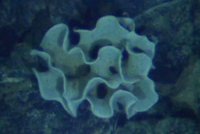Xenophyophore
|
|
| Xenophyophores | ||||
|---|---|---|---|---|
 Xenophyophore in the Galapagos Rift | ||||
| Scientific classification | ||||
| ||||
| Orders | ||||
Xenophyophores are marine protozoans, giant single-celled organisms found exclusively on the floor of the deep ocean. First described as sponges in 1889 and later as amoeboids, xenophyophores are now in their own phylum of Protista, the Xenophyophora. There are three classes within the phylum and approximately 42 recognized species in 13 genera; one of which, Syringammina fragillissima, is among the largest known protozoans at a maximum 20 centimetres in diameter.
Abundant but poorly understood, xenophyophores are delicate organisms with a variable appearance; some may resemble flattened discs, angular four-sided shapes (tetrahedra), or like frilly or spherical sponges. Local environmental conditions may play a part in influencing these forms. Xenophyophores are essentially lumps of viscous fluid called cytoplasm containing numerous nuclei distributed evenly throughout. Everything is contained in a ramose system of tubes.
As benthic particulate feeders, xenophyophores root through the muddy sediments on the sea floor. They excrete a slimy substance whilst feeding; in locations with a dense population of xenophyophores, such as at the bottoms of oceanic trenches, this slime may cover large areas. Local population densities may be as high as 2,000 individuals per 100 square metres. These giant protozoans seem to feed in a manner similar to amoebas, enveloping food items with a foot-like structure called a pseudopodium.
Their glue-like secretions cause silt and strings of their own fecal matter, called stercomes to build up on their exteriors. In this way, the organisms form structures which project from the sea floor; this characteristic also explains their name, which may be translated from the Greek to mean "bearer of foreign bodies". Xenophyophores may be an important part of the benthic ecosystem, providing a habitat for other organisms such as isopods. Research has shown that areas dominated by xenophyophores have 3-4 times the number of crustaceans, echinoderms, and molluscs than equivalent areas which lack xenophyophores.
Xenophyophores are difficult to study due to their extreme fragility. Specimens are invariably damaged during sampling, rendering them useless for cell culture. For this reason, very little is known of their life history. As they occur in all the world's oceans in great numbers, xenophyophores could be indispensable agents in the process of sediment deposition and in maintaining biological diversity in benthic ecosystems.
External links
- Microscopy-UK: Note on Xenophyophores (http://www.microscopy-uk.org.uk/mag/artnov98/xeno1.html)
- More xenophyophore photos, with a map of their habitat (http://www.soc.soton.ac.uk/GDD/DEEPSEAS/giantprotozoans.html)
